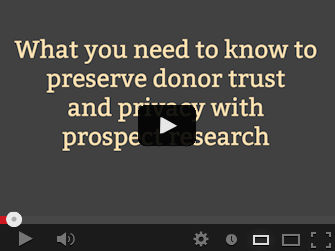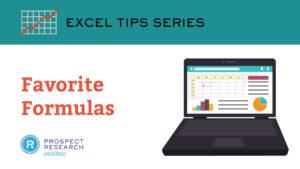 Public companies create an enormous amount of wealth in the United States. Having the designation as a public company insider is a neon-lit indicator for high net worth!
Public companies create an enormous amount of wealth in the United States. Having the designation as a public company insider is a neon-lit indicator for high net worth!
According to the McKinsey Global Institute, the consultancy’s research arm, 10% of the world’s public companies generate 80% of all profits. In 2013, the Fortune 100 biggest American companies were responsible for 46% of nominal U.S. Gross Domestic Product (GDP).
Where are the Public Company Insiders?
That is a lot of wealth! But the reality for most prospect research professionals is that the majority of our major gift prospects are going to generate their wealth through private companies. Why is this true? There are many reasons, but the chart below is a fun visual for one big reason!
Most nonprofit organizations are small relative to the heavy-weights at the top of the nonprofit sector. Universities also have the advantage of teaching the extremely successful to become that way, which frequently creates a strong affinity.
The combination of smaller operating budgets and a weaker path to affinity means that unless you research at a big organization or institution of higher education, you probably won’t come across too many public company insider prospects. There just aren’t that many of them to go around.
However, within this reality, public company prospects are a gold mine of learning opportunity!
The Old Way of Learning Donor Profile Research
Most of us entered the prospect research field as generalists. We have earned a wide variety of graduate degrees, have held jobs in a wide range of industries, and we often find financial filings to be incredibly opaque and confusing! To top it off, we have to learn how to do profile research on our own, with a hodgepodge of brief trainings if any at all.
The result is that we often face a topic as complex as public company executive and director compensation packages as a checklist task. We learn a series of actions to take to value and present the information and approach each prospect the same way, occasionally adding new learning when prospects differ.
Public companies provide us with the opportunity for a new approach.
The New Way of Learning Donor Profile Research
Public companies offer us an unfettered view of the compensation structures for their directors and executives. We can also make qualitative and quantitative comparisons of the company and its compensation packages. These two facts create a rich learning opportunity for the fundraising research professional.
When you take the time to learn and understand the reasons behind the compensation packages for public companies you can begin to apply this understanding to the ways private companies create wealth for their share owners. You can compare and contrast the public company with the private company.
Most of us in the prospect research field are not ultra-wealthy. It can be extremely difficult to imagine the wealth of a public or private company share owner. Learning how public companies create wealth for their executives through compensation packages, including company stock, gives you a strong foundation to improve and build upon your ability to value all company holdings and calculate capacity ratings.
Where Can I Learn This Kind of Information?
You can find all manner of free learning online. Khan Academy offers a free Finance and Capital Markets series. Coursera offers a free Business Finance series of courses. There is no shortage of ad hoc material on YouTube as well!
The downside to what is available for free is that it is not focused on fundraising. Because of this, the concepts being taught can feel mostly irrelevant. While you want more than cursory learning, you probably don’t need to learn everything there is to know about buying and selling stock and bonds.
There are fundraising-focused webinars, articles, and blog posts from the Association of Professional Researchers for Advancement and consultants in the field, but these often don’t explain the reasoning behind the compensation structures or how this kind of wealth can turn into a gift. They are by nature brief and not comprehensive.
Out of frustration with this situation, I helped create a comprehensive, 5-week course introducing prospect research professionals to the world of public company compensation. It was exciting to pull all the pieces together and create a safe space in an online classroom to have conversations about researching and fundraising with public company prospects.
Public company insiders may not show up on your prospect list terribly often, but I’m suggesting that if you view them as an opportunity to deepen your knowledge about wealth creation, they can be a rich learning experience that will deepen your research and fundraising skills generally. What are your thoughts? Do you agree?
More Resources You Might Like
 Do you dream of creating the perfect prospecting system? A system so flawless that the ratio of prospects to donors drops to 2:1 or even (gasp) 1:1? I do! And yet, barring advances in ESP, a 1:1 ratio feels quite out of reach. We simply don’t have access to people’s complex, internal motivations for giving until they get visited and share. Even so, we still have plenty of room to achieve better prospect-to-donor ratios.
Do you dream of creating the perfect prospecting system? A system so flawless that the ratio of prospects to donors drops to 2:1 or even (gasp) 1:1? I do! And yet, barring advances in ESP, a 1:1 ratio feels quite out of reach. We simply don’t have access to people’s complex, internal motivations for giving until they get visited and share. Even so, we still have plenty of room to achieve better prospect-to-donor ratios. Partner with a prospect research professional! As a fundraiser, why should you partner with a prospect research professional to find new prospects? Couldn’t you use a research software product or buy a prospect list?
Partner with a prospect research professional! As a fundraiser, why should you partner with a prospect research professional to find new prospects? Couldn’t you use a research software product or buy a prospect list? Public companies create an enormous amount of wealth in the United States. Having the designation as a public company insider is a neon-lit indicator for high net worth!
Public companies create an enormous amount of wealth in the United States. Having the designation as a public company insider is a neon-lit indicator for high net worth!
 Whether it’s a personal story or a media headline, we’ve all heard of incidents where data was mishandled or misunderstood and donors felt betrayed. And yet, many development and advancement offices continue to place little value on their information and data.
Whether it’s a personal story or a media headline, we’ve all heard of incidents where data was mishandled or misunderstood and donors felt betrayed. And yet, many development and advancement offices continue to place little value on their information and data.
 Two of the strongest characteristics prospect research professionals have in common is insatiable curiosity combined with a surprising boldness. We are proudly generalists! And very good at it too.
Two of the strongest characteristics prospect research professionals have in common is insatiable curiosity combined with a surprising boldness. We are proudly generalists! And very good at it too.
 Gift capacity ratings were a marketing moment for wealth screening companies. Suddenly thousands of records could be matched individually to wealth records and assigned a score. Your constituents could be assessed by their potential capacity – in the form of dollars. And everybody loves money. Have gift capacity ratings lived up to the hype? Yes!
Gift capacity ratings were a marketing moment for wealth screening companies. Suddenly thousands of records could be matched individually to wealth records and assigned a score. Your constituents could be assessed by their potential capacity – in the form of dollars. And everybody loves money. Have gift capacity ratings lived up to the hype? Yes!
 Are you proud of the work that you do? Do you get excited about solving information challenges at work? If so, why not take the opportunity this month to share your
Are you proud of the work that you do? Do you get excited about solving information challenges at work? If so, why not take the opportunity this month to share your 
 Guest post by Darrel Spacone
Guest post by Darrel Spacone About Darrel Spacone, bCRE
About Darrel Spacone, bCRE